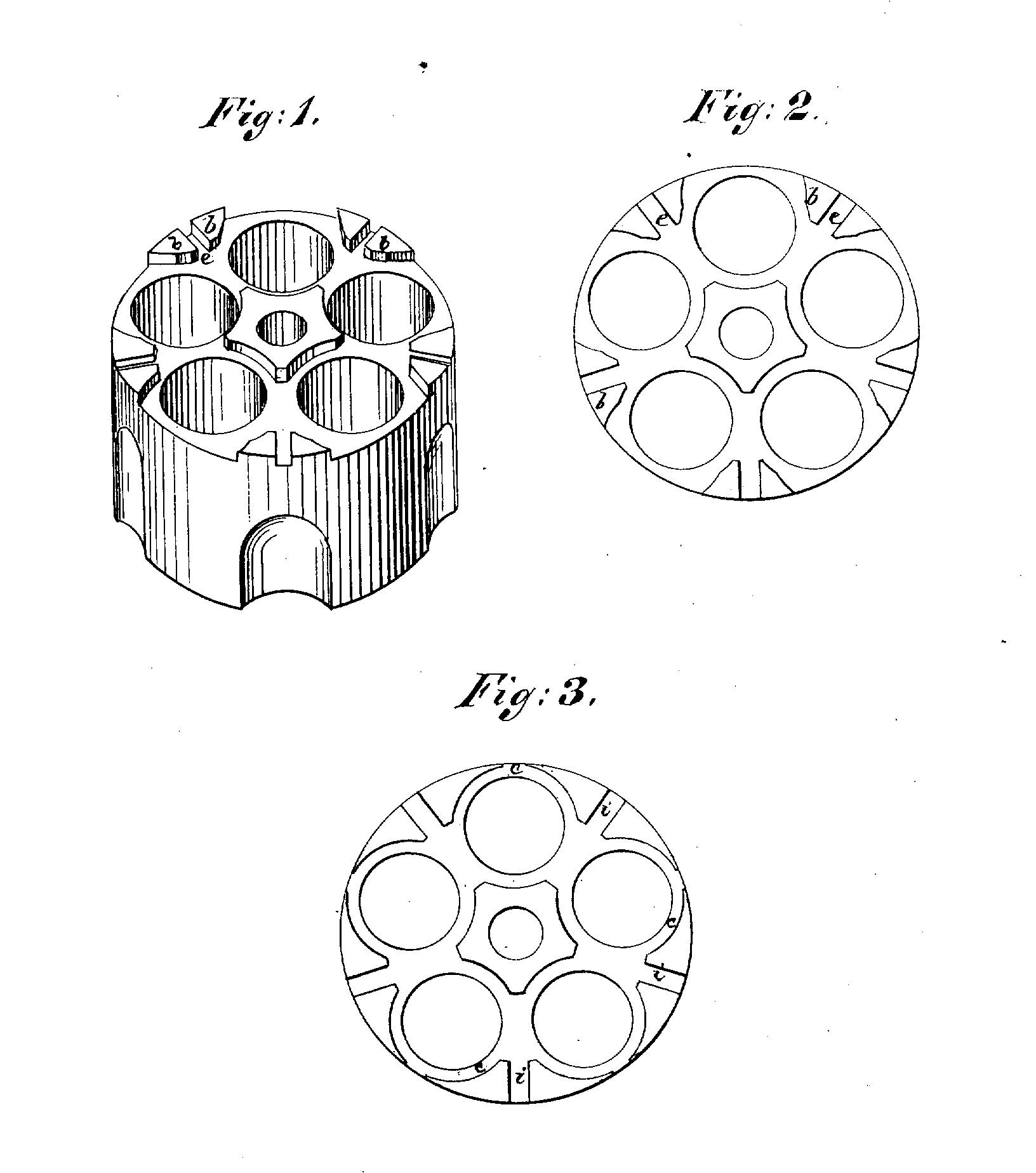US 162475
UNITED STATES PATENT OFFICE.
HENRY H. HOPKINS, OF NORWICH, CONNECTICUT,
IMPROVEMENT IN REVOLVING FIRE-ARMS
Specification forming part of Letter Patent No. 162,475, dated April 27, 1875; application filed March 24, 1875.
To all whom it may concern:
Be it known that I, Henry H. Hopkins, of Norwich, New London county, in the State of Connecticut, have invented an Improvement in the Cylinders of Revolver Breech-Loading Fire-Arms, of which the following is a specification, reference being had to the accompanying drawings, forming part thereof.
Fig. 1 is a perspective view of a cylinder containing my improvement. Fig. 2 is a face of the rear end of the same. Fig. 3 is a similar view of a cylinder made in the ordinary form.
My invention relates to revolver breech-loading fire-arms, and particularly to the safety-notch in the rear end face of the cylinder, and consists in safety-notches made in projections so formed on the rear end of the cylinder, that blows of the hammer upon such projections, outside of the notches, will not force the metal of the projection inward against, or so as to interfere with, head of the cartridge, as hereinafter particularly described.
A is a cylinder, designed for a breech-loading revolver fire-arm. The other parts of the arm are not shown, it not being deemed necessary to do so, as the said cylinder may be used in any one of a number of well-known arms, in the ordinary way.
It is desirable that this class of cylinder be provided with safety-notches— that is, notches made in the rear face, at its periphery, in which the nose of the hammer of the lock of the arm may rest, when the arm is not in use, to avoid the danger of accidental explosion of the cartridges.
The common way of making these notches is represented in Fig. 3, such figure being given for the purpose of enabling me more definitely to describe my improvement, and make it more fully understood. As will be seen by this figure, an annular recess or countersink, c, is made in the rear face of the cylinder around each chamber to receive the flange of the cartridge. These recesses cut away the metal between them and the periphery of the cylinder, so as to leave only very thin walls, as seen at e. Through these thin walls notches are cut, into which the hammer falls in firing the cartridge, Then midway between these notches are cut the safety-notches, as seen at , Fig. 3. A serious difficulty has been experienced in the use of a cylinder thus constructed. The hammer is liable to fall upon the edge of the cylinder outside of both sets of notches, and when it does so near a firing notch, where the projecting metal is thin, the said metal is liable to be thereby forced down upon the cartridge-head, causing much mischief, such as firing the cartridge, fastening the cartridge in the cylinder, -interfering with the introduction of the cartridge-head into the said recess, and forming a burr that will prevent the unobstructed revolving of the cylinder.
The objectionable feature described is obviated by my improvement, as shown in Figs. 1 and 2. In place of making annular recesses in the end face of the cylinder for the heads of the cartridges, I leave the said face plain and smooth, excepting a number of small projections (one midway between each two of the chambers of the cylinders,) in which the safety notches are formed. In the drawings these projections are indicated by the letter b and the safety-notches by the letter e. It is essential that the walls or sides of these projections, looking toward the cartridge-heads, shall not follow the curve of the cartridge-head along toward the point where the hammer strikes the cartridge-head, but must be cut away back from the inner point of the projection towards the periphery of the cylinder sufficiently so that in practice the hammer of the gun, falling upon the outer face of the projection, cannot bend or batter down the said projection so as to carry it over onto the cartridge-head, or raise a burr or roughness on the said projection that will interfere with the free revolving of the cylinder in the frame of the fire-arm.
I claim—
A cylinder for a revolver fire-arm, provided with safety-notches e in the projection b on the end face of the said cylinder, the said projections being formed as described, so that the hammer of the fire-arm falling upon such projections will not, in practice, force the metal of the projection inward into the space intended for the periphery of the cartridge-head, or form a burr or roughness that will interfere with the revolution of the cylinder in the frame or stock of the fire-arm, as specified.
Witness my hand this 22d day of March, 1875.
HENRY H. HOPKINS,
Witnesses:
Joseph Merwin,
B. S. Clark.

